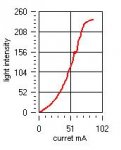This started over in another thread - I'm reposting it on its own.
woop:
I am actually thinking of rigging up a power curve setup. I don't have a laser power meter, so it will just be using a solar cell or phototransistor and having relative results, unless anyone has any experience calibrating a laser meter with household objects?
I will hook up the current, power and maybe temperature readings to the ADC input of a microcontroller and transmit readings by serial to my PC which will draw a graph in real time thinking this might be of some use!
Zarniwoop:
As it happens I'm experimenting with making a power meter too.
Things to consider - the spectral response of a solar cell varies (fairly linearly) with the light wavelength. You've also got to reduce the light that hits the cell to the point that you don't saturate it with whatever you max mW will be. If you use a lens to spread the beam, it will refract different wavelengths to different degrees, and some lenses will absorb some wavelengths like UV. Then of course there's calibrating it.
I may never get anything useful out of this but it's a fun experiment.
woop:
i was thinking about such things like saturation. i don't think the frequency response is going to matter that much, as i am only going to be using it with reds at the moment.
how are you going to capture the data?
what sort of sensor do commercial meters use? i am thinking of a phototransistor simply because it is easier to implement, i will need a voltage that varies with light intensity from 0-5V for the ADC to be most accurate, so to use a solar cell i will need an amplifier, and that adds another layer of non-linearity
unless i have some way to calibrate it i can pretty much forget about getting accurate mW readings, but i should still get an accurate curve, and the current measurements are easy enough to get accurate.
I could always compare my graph to someone else's and calibrate it that way, assuming a similar diode is being used and the temperatures are the same.
woop:
I am actually thinking of rigging up a power curve setup. I don't have a laser power meter, so it will just be using a solar cell or phototransistor and having relative results, unless anyone has any experience calibrating a laser meter with household objects?
I will hook up the current, power and maybe temperature readings to the ADC input of a microcontroller and transmit readings by serial to my PC which will draw a graph in real time thinking this might be of some use!
Zarniwoop:
As it happens I'm experimenting with making a power meter too.
Things to consider - the spectral response of a solar cell varies (fairly linearly) with the light wavelength. You've also got to reduce the light that hits the cell to the point that you don't saturate it with whatever you max mW will be. If you use a lens to spread the beam, it will refract different wavelengths to different degrees, and some lenses will absorb some wavelengths like UV. Then of course there's calibrating it.
I may never get anything useful out of this but it's a fun experiment.
woop:
i was thinking about such things like saturation. i don't think the frequency response is going to matter that much, as i am only going to be using it with reds at the moment.
how are you going to capture the data?
what sort of sensor do commercial meters use? i am thinking of a phototransistor simply because it is easier to implement, i will need a voltage that varies with light intensity from 0-5V for the ADC to be most accurate, so to use a solar cell i will need an amplifier, and that adds another layer of non-linearity
unless i have some way to calibrate it i can pretty much forget about getting accurate mW readings, but i should still get an accurate curve, and the current measurements are easy enough to get accurate.
I could always compare my graph to someone else's and calibrate it that way, assuming a similar diode is being used and the temperatures are the same.






